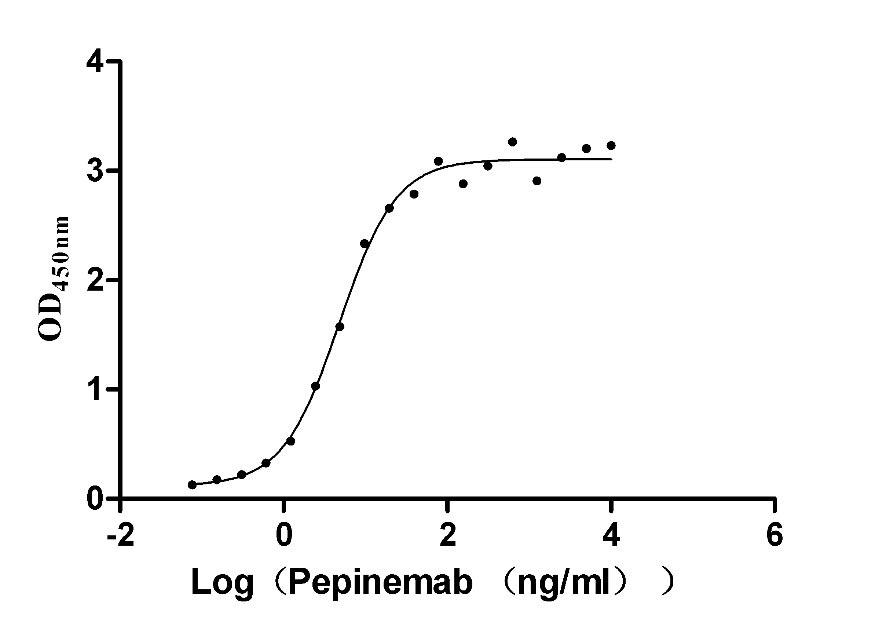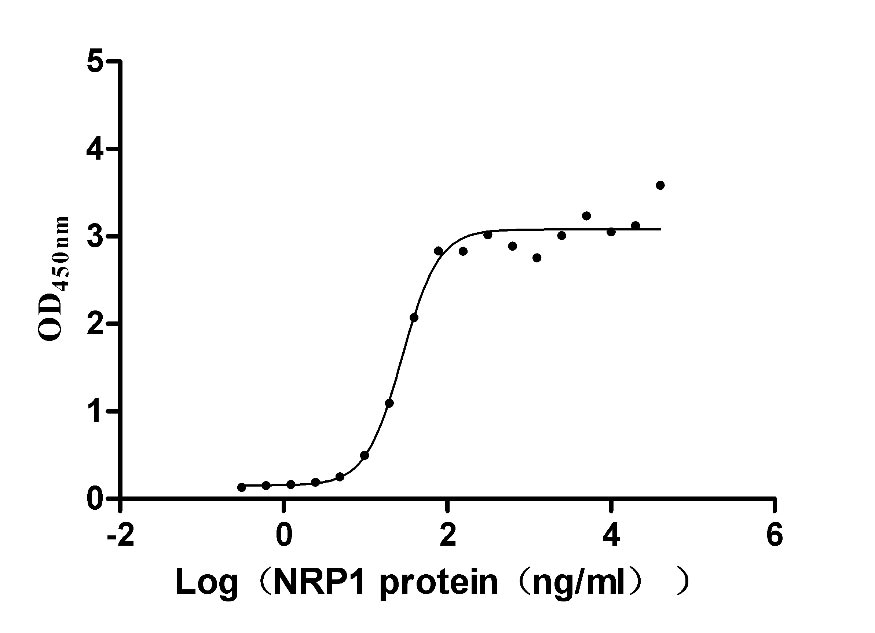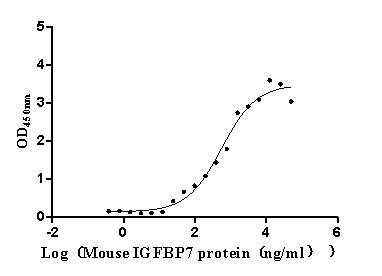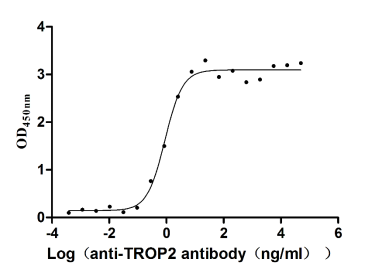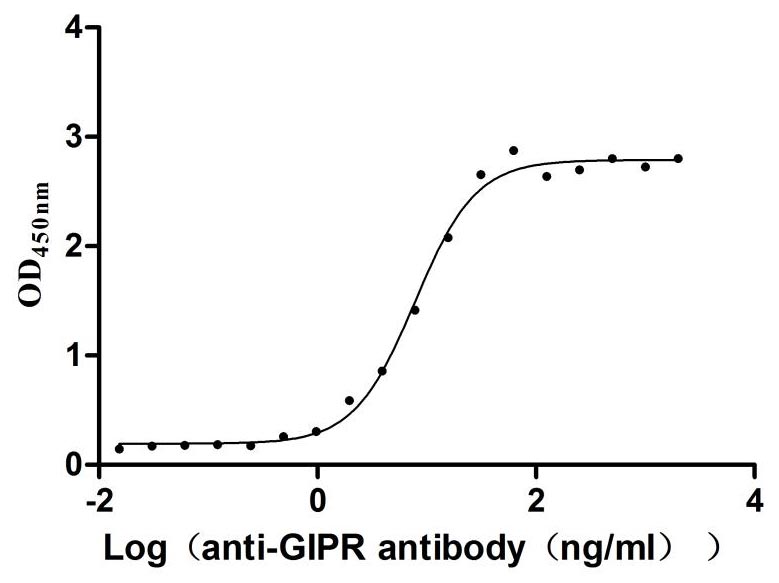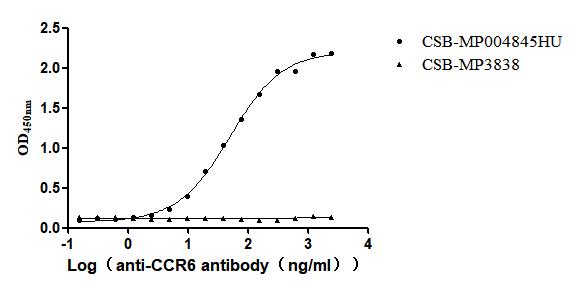Recombinant Human Ski oncogene (SKI)
-
中文名稱:人SKI重組蛋白
-
貨號:CSB-YP021356HU
-
規(guī)格:
-
來源:Yeast
-
其他:
-
中文名稱:人SKI重組蛋白
-
貨號:CSB-EP021356HU
-
規(guī)格:
-
來源:E.coli
-
其他:
-
中文名稱:人SKI重組蛋白
-
貨號:CSB-EP021356HU-B
-
規(guī)格:
-
來源:E.coli
-
共軛:Avi-tag Biotinylated
E. coli biotin ligase (BirA) is highly specific in covalently attaching biotin to the 15 amino acid AviTag peptide. This recombinant protein was biotinylated in vivo by AviTag-BirA technology, which method is BriA catalyzes amide linkage between the biotin and the specific lysine of the AviTag.
-
其他:
-
中文名稱:人SKI重組蛋白
-
貨號:CSB-BP021356HU
-
規(guī)格:
-
來源:Baculovirus
-
其他:
-
中文名稱:人SKI重組蛋白
-
貨號:CSB-MP021356HU
-
規(guī)格:
-
來源:Mammalian cell
-
其他:
產品詳情
-
純度:>85% (SDS-PAGE)
-
基因名:SKI
-
Uniprot No.:
-
別名:Avian sarcoma viral (v ski) oncogene homolog; C oncogene; C ski; Proto-oncogene c-Ski; SKI; Ski oncogene; Ski oncoprotein; SKI_HUMAN; SKV; v ski avian sarcoma viral oncogene homolog; v ski sarcoma viral oncogene homolog
-
種屬:Homo sapiens (Human)
-
蛋白長度:Full length protein
-
表達區(qū)域:1-728
-
氨基酸序列MEAAAGGRGC FQPHPGLQKT LEQFHLSSMS SLGGPAAFSA RWAQEAYKKE SAKEAGAAAV PAPVPAATEP PPVLHLPAIQ PPPPVLPGPF FMPSDRSTER CETVLEGETI SCFVVGGEKR LCLPQILNSV LRDFSLQQIN AVCDELHIYC SRCTADQLEI LKVMGILPFS APSCGLITKT DAERLCNALL YGGAYPPPCK KELAASLALG LELSERSVRV YHECFGKCKG LLVPELYSSP SAACIQCLDC RLMYPPHKFV VHSHKALENR TCHWGFDSAN WRAYILLSQD YTGKEEQARL GRCLDDVKEK FDYGNKYKRR VPRVSSEPPA SIRPKTDDTS SQSPAPSEKD KPSSWLRTLA GSSNKSLGCV HPRQRLSAFR PWSPAVSASE KELSPHLPAL IRDSFYSYKS FETAVAPNVA LAPPAQQKVV SSPPCAAAVS RAPEPLATCT QPRKRKLTVD TPGAPETLAP VAAPEEDKDS EAEVEVESRE EFTSSLSSLS SPSFTSSSSA KDLGSPGARA LPSAVPDAAA PADAPSGLEA ELEHLRQALE GGLDTKEAKE KFLHEVVKMR VKQEEKLSAA LQAKRSLHQE LEFLRVAKKE KLREATEAKR NLRKEIERLR AENEKKMKEA NESRLRLKRE LEQARQARVC DKGCEAGRLR AKYSAQIEDL QVKLQHAEAD REQLRADLLR EREAREHLEK VVKELQEQLW PRARPEAAGS EGAAELEP
-
蛋白標簽:Tag?type?will?be?determined?during?the?manufacturing?process.
The tag type will be determined during production process. If you have specified tag type, please tell us and we will develop the specified tag preferentially. -
產品提供形式:Lyophilized powder
Note: We will preferentially ship the format that we have in stock, however, if you have any special requirement for the format, please remark your requirement when placing the order, we will prepare according to your demand. -
復溶:We recommend that this vial be briefly centrifuged prior to opening to bring the contents to the bottom. Please reconstitute protein in deionized sterile water to a concentration of 0.1-1.0 mg/mL.We recommend to add 5-50% of glycerol (final concentration) and aliquot for long-term storage at -20℃/-80℃. Our default final concentration of glycerol is 50%. Customers could use it as reference.
-
儲存條件:Store at -20°C/-80°C upon receipt, aliquoting is necessary for mutiple use. Avoid repeated freeze-thaw cycles.
-
保質期:The shelf life is related to many factors, storage state, buffer ingredients, storage temperature and the stability of the protein itself.
Generally, the shelf life of liquid form is 6 months at -20°C/-80°C. The shelf life of lyophilized form is 12 months at -20°C/-80°C. -
貨期:Delivery time may differ from different purchasing way or location, please kindly consult your local distributors for specific delivery time.Note: All of our proteins are default shipped with normal blue ice packs, if you request to ship with dry ice, please communicate with us in advance and extra fees will be charged.
-
注意事項:Repeated freezing and thawing is not recommended. Store working aliquots at 4°C for up to one week.
-
Datasheet :Please contact us to get it.
相關產品
靶點詳情
-
功能:May play a role in terminal differentiation of skeletal muscle cells but not in the determination of cells to the myogenic lineage. Functions as a repressor of TGF-beta signaling.
-
基因功能參考文獻:
- The correlation between serum concentrations of IgG4 and SKI methylation levels suggest SKI might be involved in the pathogenesis of autoimmune pancreatitis (AIP). PMID: 29534839
- A microRNA miR-155 regulates transforming growth factor-beta TGF-beta-induced human coronary artery endothelial cells fibrogenic endothelial-mesenchymal transition via the regulator of TGF-beta signaling c-Ski to affect cardiac fibrosis, and miR-155/c-Ski may represent novel biomarkers and therapeutic targets for cardiac fibrosis. PMID: 28607031
- Study identified Ski as a functional tumor suppressor with frequent epigenetic inactivation in lung cancer. PMID: 28398634
- Transforming Growth Factor beta inhibitor peptide P144 downregulates SKI and an upregulates SMAD7 at both transcriptional and translational levels in glioblastoma cell lines. PMID: 27473823
- miR-1908 had a positive role in scar formation by suppressing Ski-mediated inflammation and fibroblast proliferation in vitro and in vivo. PMID: 27256397
- Overexpression of Ski wild type, but not S326D and S383D mutants inhibited centrosome amplification and cellular transformation induced by AURKA. PMID: 26138431
- our findings suggest that Ski represses TGF-b-induced EMT and invasion by inhibiting SMAD-dependent signaling in non-small cell lung cancer PMID: 25955797
- Ski regulates Hippo and TAZ signaling to suppress breast cancer progression. PMID: 25670202
- Eight recurrent and three novel SKI mutations from eleven SGS patients were located in the R-SMAD binding domain, except for one in the DHD domain. PMID: 24736733
- acetaldehyde up-regulates COL1A2 by modulating the role of Ski and the expression of SMADs 3, 4, and 7. PMID: 24641900
- c-Ski is an important regulator in the activation of CAFs and may serve as a potential therapeutic target to block breast cancer progression. PMID: 24011664
- Ski expression is a novel negative feedback mechanism acting on retinoic acid signaling PMID: 23441061
- Overall, these studies demonstrate altered Ski protein levels, degradation and localization in human papillomavirus16-transformed human keratinocytes and in cervical cancer. PMID: 23809940
- The 1p36.33-1p36.32 deletion encompassing SKI may represents a previous undescribed microdeletion disorder. PMID: 23892090
- Transgenic K562 cells have distinct gene expression profiles both in steady state and during terminal erythroid differentiation, with GATA1s expression characterised by lack of repression of MYB, CCND2 and SKI. PMID: 22853316
- The study data provide limited support for the hypothesis that common SKI variants are susceptibility factors for non-syndromic cleft lip/palate. PMID: 22984993
- We identified causative variation in ten individuals with SGS in the proto-oncogene SKI, a known repressor of TGF-beta activity. PMID: 23023332
- our findings show that in-frame mutations in exon 1 of SKI cause Shprintzen-Goldberg syndrome (SGS). PMID: 23103230
- Two genes were consistently retained in the models with clinical variables: SKI (v-SKI avian sarcoma viral oncogene homolog) and SLAMF1 (signaling lymphocytic activation molecule family member 1; CD150). PMID: 22194822
- A mutant SKI defective in transformation fails to increase p53 ubiquitination and is unable to increase MDM2 levels and to increase mono-sumoylation of Ubc9 PMID: 22411991
- Ski expression in breast neoplasms is associated with longer overall and disease-free survival. PMID: 22229264
- Forced expression of miR-29a down-regulated SKI and its target gene, Nr-CAM, whereas miR-29a inhibition induced SKI expression. PMID: 21685371
- These results suggest that c-Ski is likely involved in the carcinogenesis of CCA induced by O. viverrini infection PMID: 20853076
- impairment of SKI expression is not the leading mechanism involved in the growth-suppressive effect of miR-155 found in this malignancy. PMID: 21466664
- These data identify Ski as a novel target of Aurora A and contribute to an understanding of the role of these proteins in the mitotic process. PMID: 21600873
- Ski correlated with poor survival in the patients with TGF-beta-positive advanced gastric cancer. PMID: 21107877
- Suppression of p53 activity through the cooperative action of Ski and histone deacetylase SIRT1. PMID: 21149449
- Results identified serine 515 as a phosphorylation site of c-Ski which affects its electrophoretic motility. PMID: 20624875
- c-Ski overexpression is associated with tumor progression. PMID: 20959473
- the results suggest that association with Ski leads to inhibition of Siah2 E3 ubiquitin ligase activity and in this way, the Ski protein inhibits Siah2-mediated proteasomal degradation of HDAC3. PMID: 20691163
- SKI promotes the switch of Smad3 from repressor of proliferation to activator of oncogenesis by facilitating phosphorylations in the linker domain. PMID: 20404506
- findings show that Arkadia regulates the levels of expression of c-Ski protein in cell-type-dependent fashion, and exhibits a tumour suppressor function by inhibiting tumour cell growth PMID: 19959502
- Results indicate that SKI exploits multiple regulatory levels of the TGF-beta pathway and its deficiency restores TGF-beta tumor suppressor and apoptotic activities in spite of the likely presence of oncogenic mutations in melanoma tumors. PMID: 19845874
- c-Jun associates with the oncoprotein Ski and suppresses Smad2 transcriptional activity PMID: 12034730
- determined the crystal structure of a complex between a conserved Smad4 binding fragment of Ski and the MH2 domain of Smad4 at 2.85 A resolution PMID: 12419246
- the ability of Ski and SnoN to repress the growth inhibitory function of the Smad proteins is required for their transforming activity. PMID: 12764135
- I discuss the basis for repression of intracellular TGF-beta signaling by SKI, some additional activities of this protein, and propose that by disrupting multiple tumor suppressor pathways, SKI functions as a melanoma oncogene. PMID: 12793438
- c-ski and HIPK2 play an important role in the negative regulation of BMP-induced transcriptional activation PMID: 12874272
- SKI regulates crucial events required for melanoma growth, survival, and invasion. PMID: 14583455
- c-Ski protein has a role as a transcriptional co-repressor in TGF-beta signaling in esophageal squamous cell carcinoma PMID: 14712482
- These results suggest that stabilization of inactive Smad complexes on DNA is a critical event in c-Ski-mediated inhibition of TGF-beta signaling. PMID: 15107821
- Our data suggest that regulated proteolysis of Ski is one of the key mechanisms that control the threshold levels of this proto-oncoprotein, and thus prevents epithelial cells from becoming TGF-beta resistant. PMID: 15122324
- ski is repressed by Smad7 PMID: 15128733
- Functional Ski overexpression inhibits TGF-beta-mediated proliferation and prevents growth-arrested Schwann cells from reentering the cell cycle. PMID: 15312649
- Ski cooperates in the process of transformation in erythroid cells by interfering with GATA1 function PMID: 15542823
- Ski's increased level and specific relocalization during mitosis PMID: 15806149
- a novel polymorphism of the SKI gene was found to be associated with a decreased risk for orofacial defects PMID: 16054854
- subcellular localization of c-Ski may be regulated by proteasome-sensitive processes through amino acid residues 94-210 and 491-548 PMID: 17054724
- These results indicate that impaired competition with p300 is the possible cause of dysfunction of c-Ski/SnoN in scleroderma fibroblasts and that this might contribute to maintenance of the autocrine TGFbeta loop in this disease. PMID: 17469184
- Inhibition of Ski through RNA interference restored TGF-beta signaling and growth inhibition in vitro, and decreased tumor growth in vivo. PMID: 17592292
顯示更多
收起更多
-
相關疾病:Shprintzen-Goldberg craniosynostosis syndrome (SGS)
-
亞細胞定位:Nucleus.
-
蛋白家族:SKI family
-
數據庫鏈接:
Most popular with customers
-
Recombinant Human Semaphorin-4D (SEMA4D), partial (Active)
Express system: Mammalian cell
Species: Homo sapiens (Human)
-
Recombinant Human Neuropilin-1 (NRP1) (Active)
Express system: Mammalian cell
Species: Homo sapiens (Human)
-
Recombinant Rat Intestinal-type alkaline phosphatase 1 (Alpi) (Active)
Express system: Mammalian cell
Species: Rattus norvegicus (Rat)
-
Recombinant Mouse Complement component C1q receptor (Cd93), partial (Active)
Express system: Mammalian cell
Species: Mus musculus (Mouse)
-
Recombinant Human Tumor-associated calcium signal transducer 2 (TACSTD2), partial (Active)
Express system: Mammalian cell
Species: Homo sapiens (Human)
-
Recombinant Rat Gastric inhibitory polypeptide receptor (Gipr), partial (Active)
Express system: Mammalian cell
Species: Rattus norvegicus (Rat)
-
Recombinant Human Serine/threonine-protein kinase receptor R3 (ACVRL1), partial (Active)
Express system: Baculovirus
Species: Homo sapiens (Human)
-
Recombinant Human C-C chemokine receptor type 6(CCR6)-VLPs (Active)
Express system: Mammalian cell
Species: Homo sapiens (Human)


